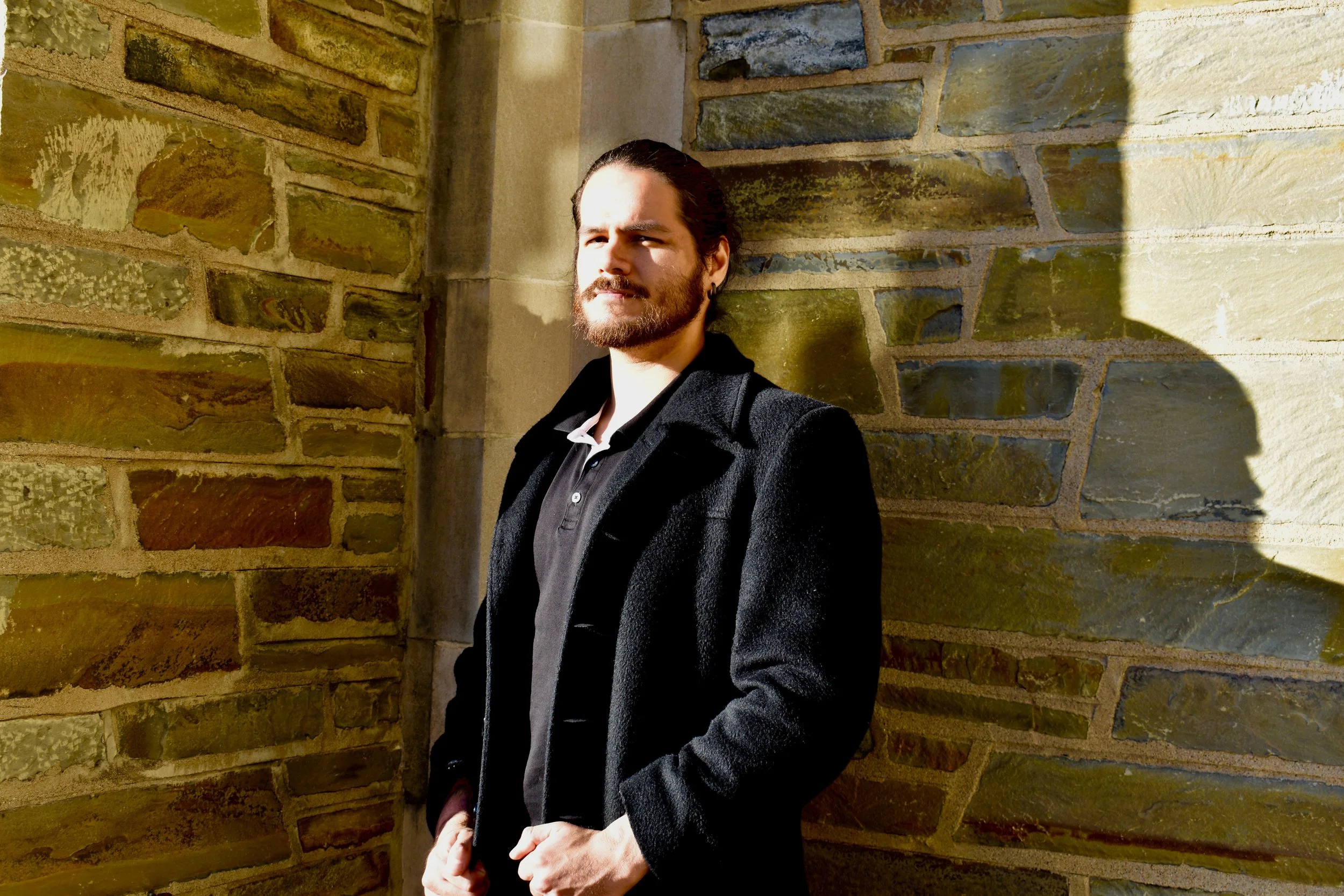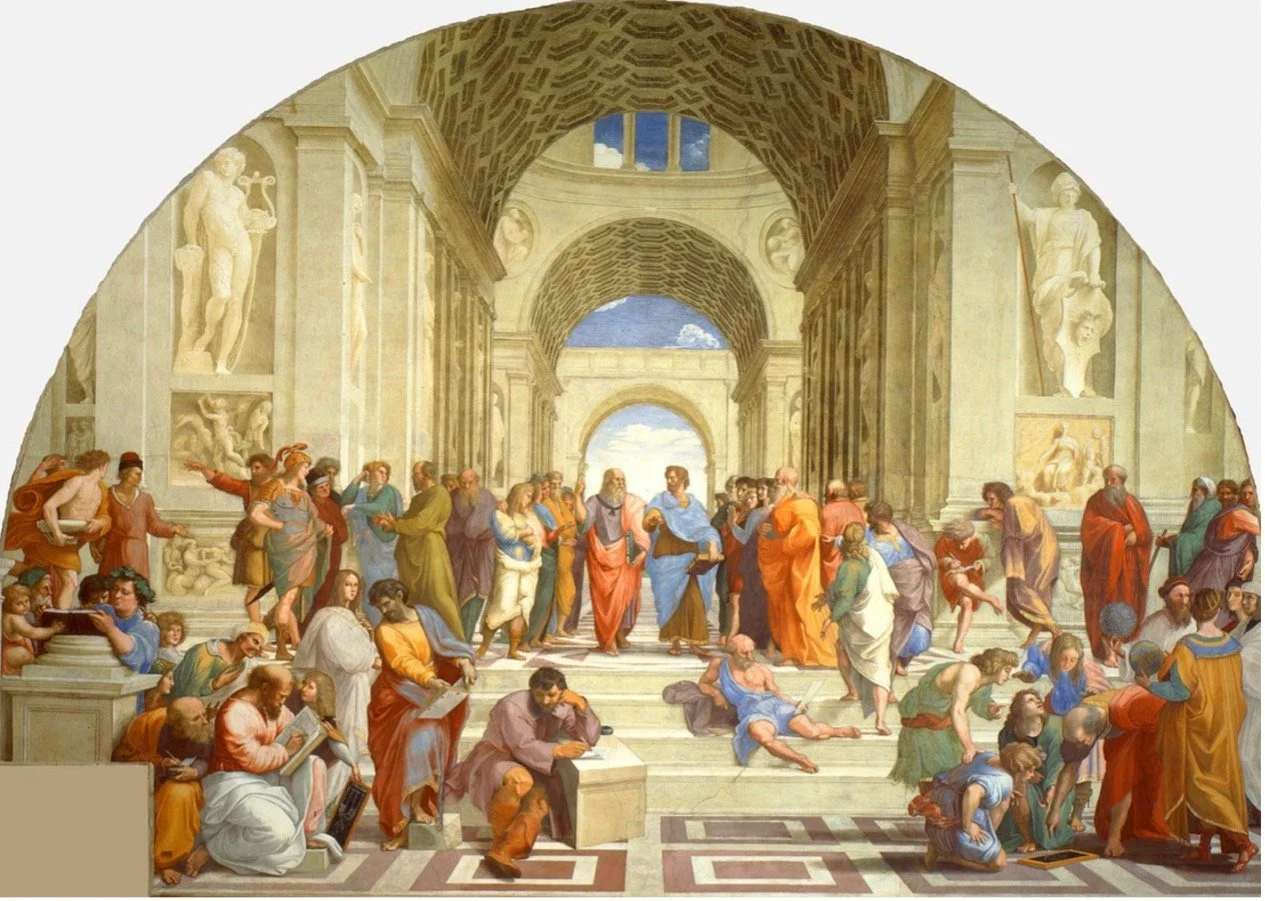Edvard Aviles-Meza is a PhD candidate in Philosophy at Cornell University. His primary interests are in the philosophy of mind and cognition, as well as epistemology. He is currently writing a dissertation on what the phenomenon of distraction teaches us about consciousness.
A post by Edvard Aviles-Meza
Have a look at Raphael’s School of Athens (figure 1 below). During a quick glance, do you see each of the individuals depicted? Surely, you wouldn’t recognize them at one glance. Moreover, you probably wouldn’t recall everything you saw. Hence, you also wouldn’t be able to tell. But my question isn’t about recognition, memory, or report; it’s more specific: do you visually experience each individual in the depicted scene during a quick glance? Many psychologists and neuroscientists would say that you don’t because visual experience, or broadly, consciousness is constrained by attention, and you can’t attend to each of them at once (Kouider et al., 2010; Cohen & Dennett, 2011). Moreover, people not only miss local details, but they also fail to notice global features such as the fact that the shape of the visual scene isn’t a rectangle since it occurs only within a lunette, and outside that frame, the appearance of depiction is an illusion. Similarly, rich conscious experience outside attention is an illusion.
Figure 1: Source: Wikiart
Before going any further, it would be helpful to introduce some terminology. When talking about consciousness, the focus here is what is known as ‘phenomenal consciousness’, that is, the subjective character of some mental states such that there is something it is like to be in those states for the subject. So, let’s call ‘the phenomenal overflow hypothesis’ (POH) (Block, 2011) the claim that sometimes phenomenal consciousness occurs outside attention and is also richer in its capacity; and let’s call ‘the gatekeeping hypothesis’ (GKH) the claim that POH is false. To the defenders of GKH, just as we know that, despite appearances, the light inside the refrigerator is off when the door is closed, we can claim that there isn’t rich conscious experience when you’re not attending. Attention is the gatekeeper of consciousness, and to believe in POH is like believing in the refrigerator light illusion. This dispute isn’t trivial since processes like attention or working memory are possibly the best candidates to explain consciousness within the computational framework of cognitive science. In this entry, I claim that there is a major aspect of our conscious experience that has been neglected from this debate, namely, imaginative experience, and bringing up imagination has the potential for a “jailbreak” against the gatekeeping hypothesis.
Let’s begin with the intuitive evidence for overflow. Since overflow concerns the dissociation between attention and consciousness, a natural place to look for it is cases of distraction. In fact, when introducing the concept of phenomenal consciousness as distinct from the access provided by attention, Block describes a case like the following (1995):
[Distraction]: While deeply absorbed in a heated and long conversation, you suddenly become aware of a pneumatic drill that has been operating loudly outside your window for quite some time. You were sensing the noise all along, but only after that point did you pay attention to it.
Why should we think this is an auditory experience outside attention rather than mere unconscious processing? Silins captures the overflow intuition clearly (2018, p.15): “The motivation is not just that, when I turn my attention to the sound, I experience the sound, but also that, when I turn my attention to the sound, I sometimes seem to have been experiencing the sound before I turned my attention to it”. So, inattentive experience is motivated by a memory appearance. Denying the veridicality of that apparent memory by invoking unconscious processing seems just a skeptical hypothesis. However, overflow doesn’t come easily.
Even if we accept that in [Distraction] there is inattentive experience, it isn’t enough for overflow since POH also concerns richness, and your inattentive experience could have been informationally poor and generic (“gist-like”). Thus, to make a compelling case for POH, we need not only (i) inattentive experience, but also (ii) rich conscious experience. My conjecture is that we can meet this desideratum by considering a special kind of imaginative experience:
[Absent-Mindedness]: You find yourself extremely bored during a logic class, and you can’t focus anymore. Suddenly, your mind starts wandering. A collection of spontaneous thoughts pops up in your mind, flooding the stream of consciousness with random images. Ultimately, you zone out for a while, becoming completely absent-minded; that is, you’re no longer paying attention to your surroundings nor to what’s going on in your own mind. When the professor calls your name, you become aware that your mind has been wandering.
As in the previous example, this case embeds the apparent memory that while distracted, your experience took place in the background regardless. During extended episodes of daydreaming, there are occasional intervals of absent-mindedness and intermittent awareness until you catch your own mind wandering. The “self-catch” is an important introspective datum because you recall having been imagining something just before that. But to argue efficiently against GKH, we need to move beyond intuition. So, let’s look at some empirical evidence.
Mind-wandering is a common response to distraction. Psychologists define it as “decoupled attention”, that is, our focus is disengaged from a contextually relevant task, generating spontaneous thoughts (Smallwood & Schooler, 2015). In typical studies, participants do tedious, attention-demanding tasks (like reading long, boring texts) while trying to report every episode of mind-wandering. They do this through a method known as “experience sampling”, which works in two ways: spontaneously when they notice it happening (self-caught), or after hearing a random sound cue that prompts them to check their mental state (probe-caught). Here’s where it gets interesting: sometimes there is a mismatch in that people only report mind-wandering after the sound cue, even though they were instructed to catch it themselves (Schooler et al., 2011). But if subjects needed an external cue to catch that they were mind-wandering (even though they were told to do it by themselves), then, assuming the reports are sincere, either they deliberately ignored the instructions or they were not aware of those wandering episodes. The latter strongly suggests that some spontaneous imaginings give rise to a radical form of decoupling—‘double decoupling’—in which attention is disengaged both from the external environment and from internal monitoring. In other words, with [Absent-Mindedness], we get imagery in the near absence of attention instead of attention off-task. However, to get overflow, we need to determine whether inattentive imaginings are informationally rich rather than merely gist-like.
Fortunately, there is a strong theoretical motivation in favor of richness, and it comes from considering representational formats. These are roughly ways in which the information is structured and processed by the cognitive system. Philosophers usually distinguish two broad formats: discursive (language-like) and iconic (picture-like). Following the idea that “a picture is worth a thousand words”, there is agreement that iconic formats tend to be informationally rich because they structure the information holistically. Consider again Raphael’s School of Athens. Most regions densely package information about different features at once (e.g., shape, color, texture, etc.). The same is true of other icons that are better vehicles of mental representations, such as maps (e.g., they represent location, proximity, boundaries, etc.) but it isn’t true of discursive vehicles such as sentences, where each constituent represents one aspect of the world. Now, what’s the best candidate for iconicity in cognition? Yes, you are right, it’s mental imagery.
The previous theoretical considerations can be supported with some empirical evidence from cognitive neuroscience. While not universal, informationally rich states tend to recruit more computational resources; hence, more activity should be expected from its neural correlates. As it happens, the neural correlate of mind-wandering—the brain’s default mode network (DMN)—is more active during episodes of mind-wandering without awareness like [Absent-Mindedness] than in ordinary mind-wandering (Christoff et al., 2009).
So, let’s make explicit the general recipe for overflow. First, find a plausible case of dissociation between attention and consciousness. This is something even some gatekeepers concede since they usually target richness (Cohen, Dennett, & Kanwisher, 2016). Second, acknowledge the connection between iconicity and informational richness. Finally, the overlap, a candidate that is both iconic and dissociates from attention, such as the inattentive imagery in [Absent-Mindedness]. This logic also applies to the classic Sperling-type experiments since they target iconic memory (Landman et al., 2003; Bronfman et al., 2014). But if any mental type is paradigmatically iconic, it’s imagery. So, mind-wandering can bolster the case for POH.
To conclude, my post suggests that the combination of empirical evidence from mind-wandering research and theoretical considerations about iconicity establishes a new case for phenomenal overflow. This is the imaginative jailbreak against the gatekeeping hypothesis.
References
Block, N. (1995). On a confusion about a function of consciousness. Behavioral and Brain Sciences, 18(2), 227–287.
Block N. (2011). Perceptual consciousness overflows cognitive access. Trends in Cognitive Sciences, 15(12), 567–575.
Bronfman, Z. Z., Brezis, N., Jacobson, H., & Usher, M. (2014). We see more than we can report: “cost free” color phenomenality outside focal attention. Psychological Science, 25(7), 1394–1403.
Cohen, M. A., & Dennett, D. C. (2011). Consciousness cannot be separated from function. Trends in Cognitive Sciences, 15(8), 358–364.
Cohen, M. A., Dennett, D. C., & Kanwisher, N. (2016). What is the Bandwidth of Perceptual Experience? Trends in Cognitive Sciences, 20(5), 324–335.
Christoff, K., Gordon, A. M., Smallwood, J., Smith, R., & Schooler, J. W. (2009). Experience sampling during fMRI reveals default network and executive system contributions to mind wandering. PNAS, 106(21), 8719–8724.
Kouider, S., de Gardelle, V., Sackur, J., & Dupoux, E. (2010). How rich is consciousness? The partial awareness hypothesis. Trends in Cognitive Sciences, 14 (7), 301–307.
Landman, R., Spekreijse, H., & Lamme, V. A. (2003). Large capacity storage of integrated objects before change blindness. Vision Research, 43(2), 149–164.
Schooler, J. W., Smallwood, J., Christoff, K., Handy, T. C., Reichle, E. D., & Sayette, M. A. (2011). Meta-awareness, perceptual decoupling and the wandering mind. Trends in Cognitive Sciences, 15 (7), 319–326.
Smallwood, J., & Schooler, J. W. (2015). The science of mind wandering: empirically navigating the stream of consciousness. Annual Review of Psychology, 66, 487–518.
Silins, N. (2018). The Evil Demon Inside. Philosophy and Phenomenological Research, 100 (2), 325-343.


